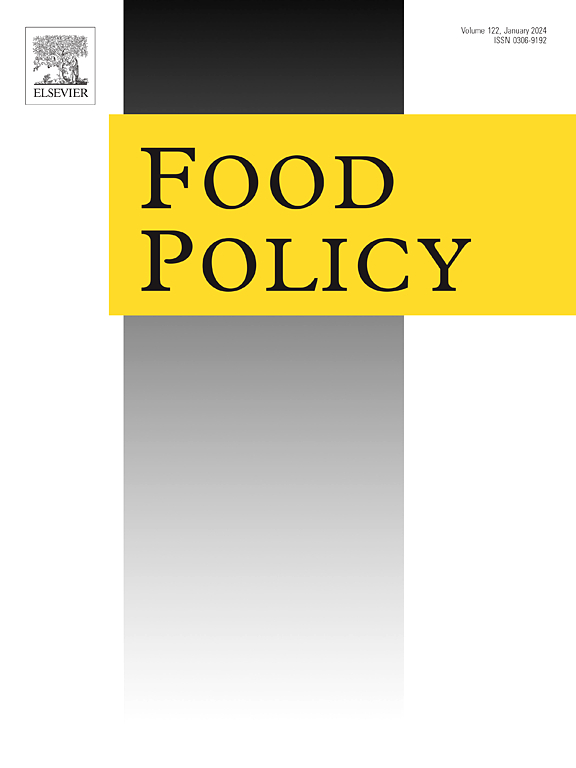中国生物经济供应链的风险暴露程度有多大?
IF 6
1区 经济学
Q1 AGRICULTURAL ECONOMICS & POLICY
引用次数: 0
摘要
生物经济供应链的稳定性对国家安全和环境可持续性都至关重要。本研究采用全球供应链视角,基于经合组织ICIO数据表,主要利用进口侧外国生产风险敞口(FPEM)指标评估中国生物经济的风险敞口。研究结果表明,中国生物经济各部门的国内外风险暴露总体水平相对较高,这使得中国比美国和欧盟更容易受到供应链中断的影响。然而,中国生物经济领域的境外风险敞口比例仍然相对较低,约为7%至12%。此外,中国生物经济对外风险敞口的透视一直超过其对外风险敞口的面值,这表明某些对外供应链风险可能被掩盖了。值得注意的是,农业部门的境外风险敞口增幅最大,这意味着潜在风险逐步上升。虽然食品部门隐藏的外国风险暴露显示出相对较低的波动性,但其潜在的外部依赖性仍然是一个不应低估的关键问题。此外,我们的研究表明,美国和中国互为生物经济中间投入的最大实际外国供应国。本研究不仅为中国生物经济供应链的风险管理提供了重要的见解,也为全球生物经济供应链的安全和可持续发展提供了宝贵的经验和启示。还讨论了粮食政策的影响。本文章由计算机程序翻译,如有差异,请以英文原文为准。
What is the magnitude of risk exposure in China’s bioeconomic supply chains?
The stability of bioeconomic supply chains is crucial for both national security and environmental sustainability. This study adopts a global supply chain perspective and primarily utilizes the Import Side of Foreign Production Exposure (FPEM) indicator to assess the risk exposure of China’s bioeconomy, based on data from the OECD ICIO tables. The findings indicate that the overall levels of domestic and foreign risk exposure across various sectors of China’s bioeconomy are relatively high, which makes it more vulnerable to supply chain disruptions than the U.S. and the EU. However, the proportion of foreign risk exposure in China’s bioeconomic sectors remains relatively modest, ranging from approximately 7% to 12%. Moreover, the look through foreign risk exposure of China’s bioeconomy consistently exceeds its face value foreign risk exposure, suggesting that certain foreign supply chain risks may be concealed. Notably, the Agriculture sector shows the most significant increase in look through foreign risk exposure, implying a gradual rise in potential risks. While the hidden foreign risk exposure in the Food sector demonstrates relatively low volatility, its underlying external dependencies remain a critical concern that should not be underestimated. Additionally, our research shows that the U.S. and China are each other’s largest actual foreign suppliers of intermediate inputs in the bioeconomy. This study not only provides critical insights for the risk management of China’s bioeconomic supply chains but also offers valuable lessons and implications for the security and sustainable development of global bioeconomic supply chains. Food policy implications are also discussed.
求助全文
通过发布文献求助,成功后即可免费获取论文全文。
去求助
来源期刊

Food Policy
管理科学-农业经济与政策
CiteScore
11.40
自引率
4.60%
发文量
128
审稿时长
62 days
期刊介绍:
Food Policy is a multidisciplinary journal publishing original research and novel evidence on issues in the formulation, implementation, and evaluation of policies for the food sector in developing, transition, and advanced economies.
Our main focus is on the economic and social aspect of food policy, and we prioritize empirical studies informing international food policy debates. Provided that articles make a clear and explicit contribution to food policy debates of international interest, we consider papers from any of the social sciences. Papers from other disciplines (e.g., law) will be considered only if they provide a key policy contribution, and are written in a style which is accessible to a social science readership.
 求助内容:
求助内容: 应助结果提醒方式:
应助结果提醒方式:


